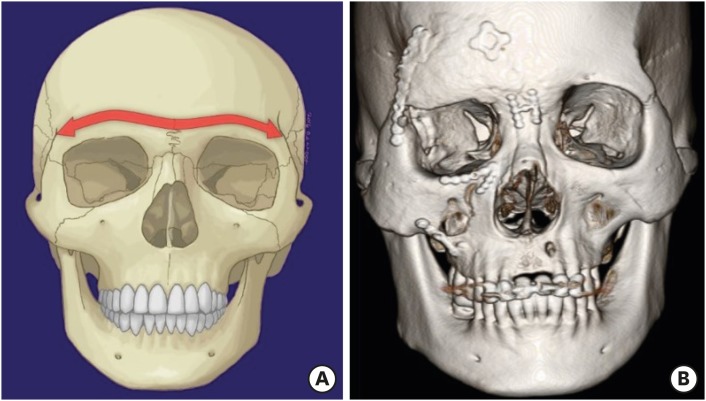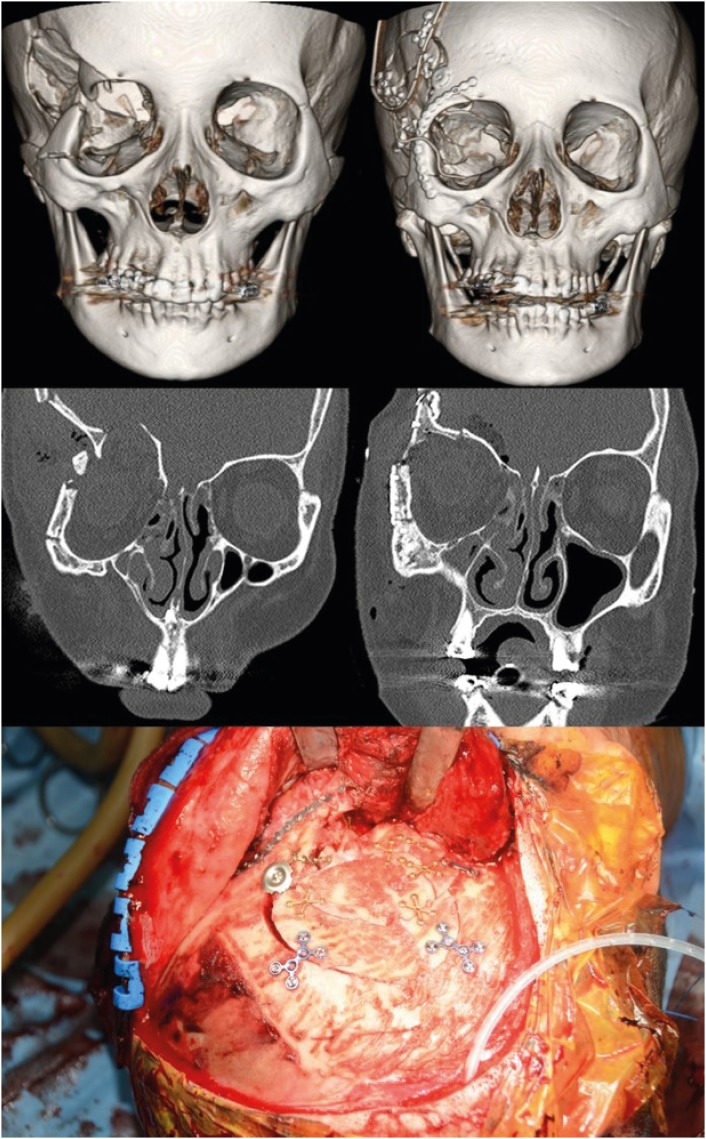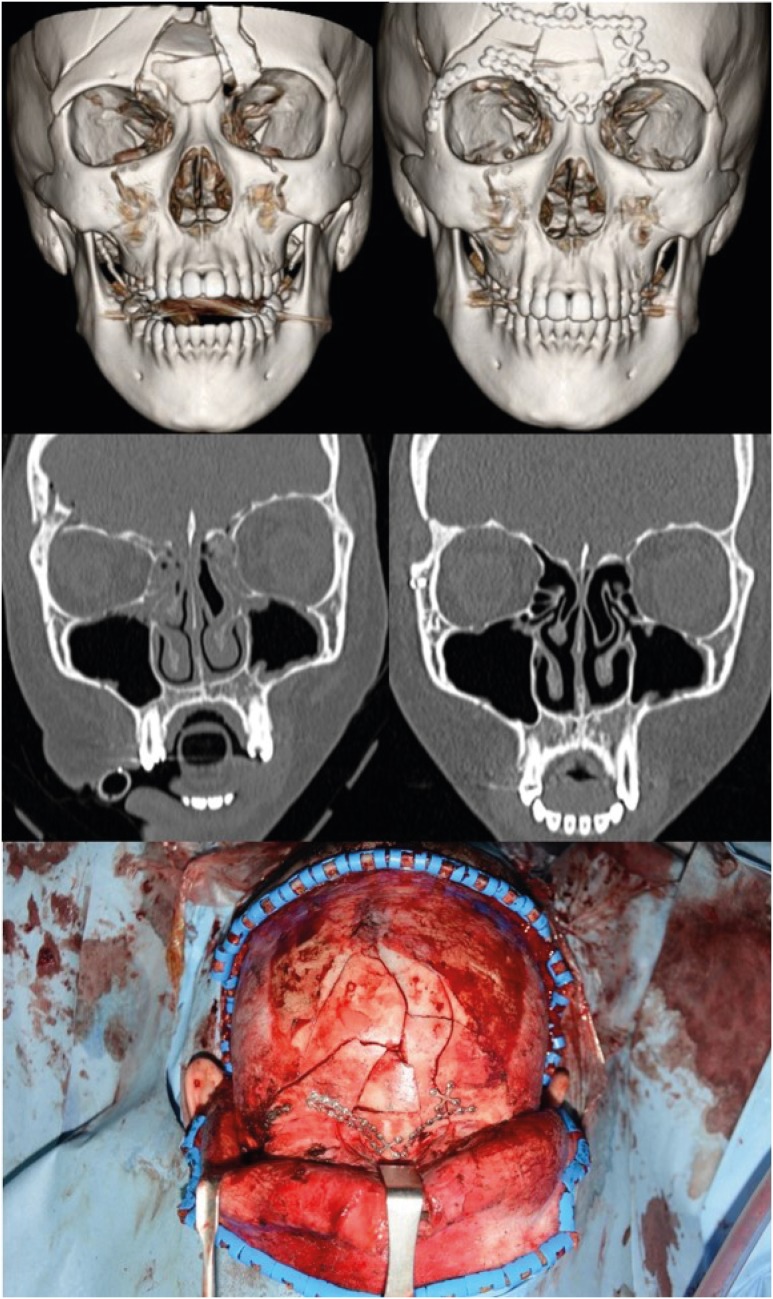Korean J Neurotrauma.
2019 Apr;15(1):11-18. 10.13004/kjnt.2019.15.e12.
Restoration of the Fronto-Orbital Buttress with Primary Bone Fragments
- Affiliations
-
- 1Department of Plastic and Reconstructive Surgery, Dankook University Hospital, Cheonan, Korea. dhkcool@daum.net, dhkcool@naver.com
- KMID: 2444200
- DOI: http://doi.org/10.13004/kjnt.2019.15.e12
Abstract
OBJECTIVE
Forehead deformities are often caused by lack of treatment or incorrect restoration of the frontal buttress, so the underlying frontal buttress should be restored to its previous position to ensure that the previous forehead contour is restored in cases of complex depressed skull fractures. However, since brain injuries from skull fractures could have fatal consequences, the clinical concern in primary surgery has been to save the patient's life, and cosmetic concerns have always been secondary. We retrospectively reviewed fronto-orbital fracture patients who underwent primary restoration with primary bone fragments or an alloplastic implant and compared the surgical outcomes of autologous bone (group 1) and artificial materials (group 2).
METHODS
A retrospective review was conducted of 47 patients with fronto-orbital fractures between March 2012 and January 2018. The patients underwent primary reconstruction with primary bone fragments or an alloplastic implant. The surgical results were evaluated by the incidence of infection and cosmetic satisfaction of patients.
RESULTS
Infections occurred in one patient (5%) in group 1 and in two patients (15.3%) in group 2, which was not a statistically significant difference. In contrast, at 6 months after surgery, patient satisfaction showed a statistically significant between-group difference (group 1: 4.32 points, group 2: 3.54 points, p=0.001).
CONCLUSION
Primary reconstruction using fractured bone fragments is an effective and preferable method that could result in better surgical outcomes than restoration using an alloplastic implant.
Keyword
MeSH Terms
Figure
Reference
-
1. Benzil DL, Robotti E, Dagi TF, Sullivan P, Bevivino JR, Knuckey NW. Early single-stage repair of complex craniofacial trauma. Neurosurgery. 1992; 30:166–171. PMID: 1545883.
Article2. Blankenship JB, Chadduck WM, Boop FA. Repair of compound-depressed skull fractures in children with replacement of bone fragments. Pediatr Neurosurg. 1990–1991; 16:297–300.
Article3. Braakman R. Depressed skull fracture: data, treatment, and follow-up in 225 consecutive cases. J Neurol Neurosurg Psychiatry. 1972; 35:395–402. PMID: 5035313.
Article4. Cho YJ, Kim YO, Song JH, Hwang JH, Kim SM, Ahn MS, et al. Immediate replacement of bone fragments in compound comminuted depressed skull fractures. J Korean Neurosurg Soc. 2000; 29:668–674.5. Curtis W, Horswell BB. Panfacial fractures: an approach to management. Oral Maxillofac Surg Clin North Am. 2013; 25:649–660. PMID: 23988567.6. Haines SJ. Efficacy of antibiotic prophylaxis in clean neurosurgical operations. Neurosurgery. 1989; 24:401–405. PMID: 2648181.
Article7. Kriss FC, Taren JA, Kahn EA. Primary repair of compound skull fractures by replacement of bone fragments. J Neurosurg. 1969; 30:698–702. PMID: 5787846.
Article8. Markowitz BL, Manson PN. Panfacial fractures: organization of treatment. Clin Plast Surg. 1989; 16:105–114. PMID: 2924486.
Article
- Full Text Links
- Actions
-
Cited
- CITED
-
- Close
- Share
- Similar articles
-
- Orbital wall restoration with primary bone fragments in complex orbital fractures: A preliminary study
- Orbital wall restoration with primary bone fragments in complex orbital fractures
- Use of a Titanium Buttress to Prevent Implant Displacement in Extensive Orbital Blowout Fracture
- Orbital wall restoring surgery with primary orbital wall fragments in blowout fracture
- Autogenous Calvarial Particulate Bone Grafting in Craniosynostosis




